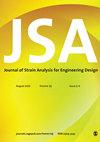玻璃钢增强高性能玻璃螺栓连接:基于简化有限元分析方法的发展
IF 1.4
4区 工程技术
Q3 ENGINEERING, MECHANICAL
Journal of Strain Analysis for Engineering Design
Pub Date : 2022-05-31
DOI:10.1177/03093247221101789
引用次数: 0
摘要
本文介绍了基于有限元(FE)计算模型的发展,该模型可用于预测gfrp增强退火和热强化玻璃螺栓连接的破坏载荷。为了建立gfrp增强玻璃螺栓连接的计算模型和合理的破坏准则,首先对单螺栓、单玻璃片情况进行了应力分析。然后根据先前涉及参考和加固双搭接试件的实验研究报告的实验结果对计算模型进行校准。本文表明,用玻璃的最大主拉应力破坏可以预测参考节点和增强玻璃螺栓连接的破坏。结果还证实,与参考玻璃螺栓连接相比,使用粘接玻璃钢加固有可能提高增强玻璃螺栓连接的承载能力。本文章由计算机程序翻译,如有差异,请以英文原文为准。
GFRP reinforced high performance glass–bolted joints: Development of a simplified finite element-based method for analysis
This paper presents the development of finite element (FE)-based computational models that can be used for predicting the failure load of GFRP-reinforced annealed and heat-strengthened glass–bolted joints. Stress analysis of a single-bolt, single-glass-piece case was first carried out in order to develop the computational models and to establish an appropriate failure criterion for the GFRP-reinforced glass–bolted joints. The computational models were then calibrated against the experimental results reported in a previous experimental study involving reference and reinforced double-lap tension joint test specimens. The paper shows that the failure of both reference and reinforced glass–bolted joints can be predicted using the maximum principal-tensile-stress-based failure of glass. The results also confirm that the use of adhesively bonded GFRP reinforcement has potential to increase the load capacity of the reinforced glass–bolted joints compared to the reference glass–bolted joints.
求助全文
通过发布文献求助,成功后即可免费获取论文全文。
去求助
来源期刊

Journal of Strain Analysis for Engineering Design
工程技术-材料科学:表征与测试
CiteScore
3.50
自引率
6.20%
发文量
25
审稿时长
>12 weeks
期刊介绍:
The Journal of Strain Analysis for Engineering Design provides a forum for work relating to the measurement and analysis of strain that is appropriate to engineering design and practice.
"Since launching in 1965, The Journal of Strain Analysis has been a collegiate effort, dedicated to providing exemplary service to our authors. We welcome contributions related to analytical, experimental, and numerical techniques for the analysis and/or measurement of stress and/or strain, or studies of relevant material properties and failure modes. Our international Editorial Board contains experts in all of these fields and is keen to encourage papers on novel techniques and innovative applications." Professor Eann Patterson - University of Liverpool, UK
This journal is a member of the Committee on Publication Ethics (COPE).
 求助内容:
求助内容: 应助结果提醒方式:
应助结果提醒方式:


